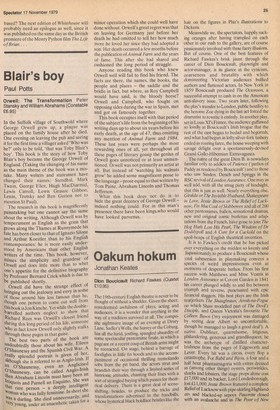Blair's boy
Paul Potts
Orwell: The Transformation Peter Stansky and William Abrahams (Constable £6.95) In the Suffolk village of Southwold where George Orwell grew up, a plaque was placed on the family house after he died. One evening on leaving the pub and seeing it for the first time a villager asked 'Who was he?' only to be told, 'that was Toby Blair's boy'. This book is the story of how Toby Blair's boy became the George Orwell of England. (Taking the changing of his name as the main theme of the book was a mistake. Many writers and statesmen have changed their names: Stendhal, Mark Twain, George Eliot, Hugh MacDiarmid, Lewis Carroll, Lewis Grassic Gibbon, Lenin, Trotsky and Ben Gurion not to mention St Paul). The research in this book is magnificently painstaking but one cannot say the same about the writing. Although Orwell was by temperament as English as the grass that grows along the Thames at Runnymede his fate has been closer to that of Ignazio Silope and Arthur Koestler than to his English contemporaries: he is more easily understood by Americans than other English writers of the time. This book, however, misses the simplicity and grandeur of Orwell and does little more than to whet one's appetite for the definitive biography by Professor Bernard Crick which is due to be published shortly. Orwell did have the strange effect of bringing out the jealousy and envy in some of those around him less famous than he, though one person to come out well from this book is Jon Kimche. Yet while the doublebarrelled authors neglect to show that Richard Rees was Orwell's closest friend during this long period of his life, someone who in fact knew Orwell only slightly stalks through these pages in that guise.
The best two parts of the book are undoubtedly those about his wife, Eileen O'Shaunessy and the Spanish Civil War. A really splendid portrait is given of, her, although she is referred to as Anglo-lnsh, If a,n; O'Shaunessy, even an Anglicised \-1 Shaunessy, can be called Anglo-Irish !hen Abraham Lincoln must have been an 'roquois and Parnell an Esquimo. She was that rare person — a deeply intelligent w2rItan who was fully feminine. In short she was a darling. She died unnecessarily, and verY young, under an anaesthetic taken for a
minor operation which she could well have done without. Orwell's great regret was that on leaving for Germany just before her death he had omitted to tell her how much more he loved her since they had adopted a son. Her death occurred a few months before the publication of A nimal Farm and the years of fame. This after she had shared and cushioned the long period of struggle.
Anyone reading this book who knew Orwell well will fail to find his friend. The facts are there, the names, the books, the people and places — the saddle and the bridle in fact, but where, as Roy Campbell would have said, is the bloody horse? Orwell and Campbell, who fought on opposing sides during the war in Spain, met and got on famously together.
This book occupies itself with that period of the subject's life from the beginning of his writing days up to about six years before his early death, at the age of 47, thus omitting any mention of Animal Farm and 1984. These last years were perhaps the most rewarding ones of all, yet throughout all these pages of literary gossip the genius of Orwell goes unnoticed or at least unmentioned. Orwell was not primarily an artist at all. But instead of 'watching his walnuts grow' he added some magnificent prose to the language —prose equal to that written by Tom Paine, Abraham Lincoln and Thomas Jefferson.
What this book does not do is to hide the great decency of George Orwell — indeed nothing could. For in this man's presence there have been kings. who would have looked parvenus.






































 Previous page
Previous page